BREAKING NEWS: Celebrated artist Paula Rego dies at 87. Rego created extraordinary and unsettling paintings often in pastel. I’ll have more for you on Friday!
***
I recently heard that Aaron Schuerr, who just last week published a guest post on How ToPastel.com about Art and Struggle, has won Best Pastel in the 11th PleinAir Salon. This is an annual award which means Aaron has won the best pastel painting of the year!
I contacted Aaron to ask him to tell us a wee something about this artwork and his experience painting it.
To my surprise and delight, rather than a few lines, Aaron sent this whole article. In it, he lists the challenges he faced while painting his winning entry. He also generously shares his secrets on painting the ocean and all its movement. Thanks Aaron!
Enjoy!
Gail
PS. Want to have a chance at winning this annual award? Then get entering! Click here to see all the details.
***
“Afternoon Glare” was the first painting I did for the 2019 Laguna Beach Plein Air Painting Invitational. If it reflects anything, it’s my excitement at painting barefoot on the beach in California!
I have to add a bit of backstory. In March of 2019 I visited Laguna Beach on a month-long painting trip. I wanted to have a look around and do a few paintings in anticipation of the Invitational later that year. I arranged to do a demo for the Laguna Plein Air Painters Association (LPAPA), and figured I’d stay a night or two and move on. Rosemary Swimm arranged (on short notice!) for me to stay with artist Rick Dalenty and his wife. Rick took me on a grand tour of the beaches in the area, and I was immediately hooked. It was a thrill to see the iconic beaches I’d enjoyed in the paintings of some of my favorite artists, (Matt Smith and Frank Serrano come to mind, along with the California Impressionists.)

What was supposed to be a quick trip stretched to five or six days. I was hooked! Thanks to the generosity of the LPAPA staff and supporters, I made new friends and was offered places to stay while painting the area.
I share all this because when I returned to Laguna Beach in the fall, I was already familiar with the area, and had rough ideas of where I wanted to go. I’d also had some time studying wave action and was familiar with the California palette. In other words, I hit the ground running. This was due in no small part to the generosity and affability of the Laguna Beach community and LPAPA.
The painting is basically a two-color complementary scheme- blue and orange. I was attracted to the sweep of rocky shore curving into the cliffs and rocks.
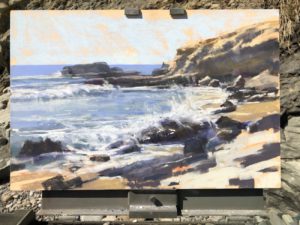
The biggest challenge was in making a clear decision about the wave action. It’s so easy to get lost painting the ocean from life. I spend a lot of time just watching, trying to understand the rhythm of wave action on rocks so I can find a moment in the cycle that is most interesting to me. Once I determine that moment, I do everything I can to stay true to that moment.
In practical terms, that is patient work. The wave might only strike the rock in that way every few minutes, so I must anticipate when it does. Then I try to catch a glimpse of the shadow patterns, the light patterns, the cast shadow, and the shape of the wave. Then I try to see if the highlight of the wave is reflected in the water. I only have time to observe one aspect of the wave each time it strikes, i.e. this time I’m observing the light patterns, next time the shadow, next cast shadow on the rocks, etc. It’s easy to get lost and make things up, but that never works.
One of the trickier aspects of wave action is paying attention to what’s happening in the periphery. I need to pay attention to what the other waves are doing in relation to the wave that’s striking the rock, and whether the ocean around it is aerated (foamy white,) or blue. I also check the tide charts, first for safety (I’ve nearly lost my entire painting kit to the ocean!), second to know if the tide is coming in or going out during the course of a painting session.
It’s surprising to me how much painting the ocean is memory work. You catch a quick glimpse, try to remember what you saw, paint a little, catch another glimpse…
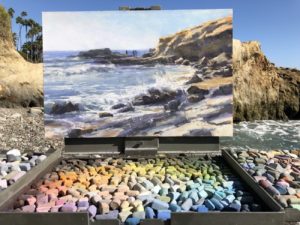
The second challenge was the figures. Part of what makes Laguna Beach interesting is all the people enjoying the beach. I wanted to include them, in part to create a sense of scale, but also just to acknowledge the human interaction. I don’t often paint figures, so that stretched me!
Finally, an argument for painting the ocean from life: We just don’t see wave action as a camera does. A photographic representation often looks static, because it’s not anything like what the human eye sees and the brain synthesizes. If you really want to get the sense of rhythm and movement, you must paint wave action from life. It can be frustrating and confusing but it’s worth the trouble. That’s not to say I won’t paint from photographs, but when I do, I draw on my experience painting the ocean from life. I try to find that inflection point between specificity and motion. I want a sense of the noise and the feel of ocean air, of the joy I feel painting barefoot on the beach, because it’s like nothing else I’ve experienced. There’s something elemental about the ocean, something that bypasses everything rational and makes me impossibly happy.
__________________________________________________________________
It’s World Ocean Day!
8th June 2022 is World Ocean Day and what better way to acknowledge the day than by enjoying this pastel painting by Edgar Degas in the Art Institute of Chicago. It’s certainly one I hadn’t seen and so I wanted to share it with you.
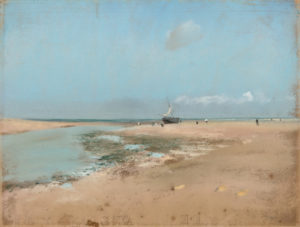
From the AIC website: ”Edgar Degas visited the coast of Normandy in the autumn of 1869 and was inspired to create over 40 small-scale landscape pastels. This particular sheet is one of the very best of this group: clearly articulated and unusual in being signed and dated, it is the only seascape that Degas relinquished during his lifetime.”

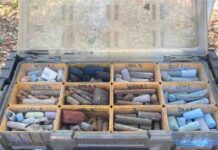
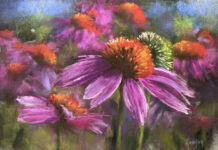

What a treat to get such a descriptive article from Aaron! I hope future contributors are encouraged to do the same. Thanks Gail for this new support in my mail for my pastel journey!
Whoo hoo Sally! And yes, it was a wonderful description and so much more than I hoped for. Aaron is a talented writer as well as a fab artist!